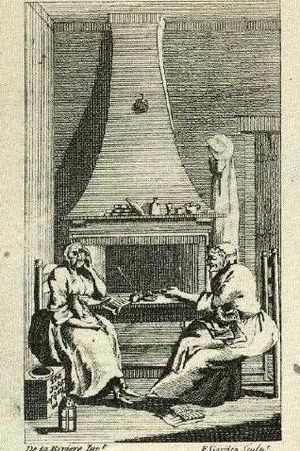Beatrix Leslie facts for kids
Quick facts for kids
Beatrix Leslie
|
|
|---|---|

The midwife (title page)
|
|
| Born | c.1577 |
| Died | 3 September 1661 (aged 83–84) |
| Cause of death | ... and burning |
| Citizenship | Scotland |
| Occupation | midwife |
| Known for | Accused of witchcraft following collapse of a coal pit |
| Spouse(s) | William Moffat |
Beatrix Leslie (born around 1577 – died September 3, 1661) was a Scottish midwife. She lived a long life but was sadly put to death for witchcraft. In 1661, she was accused of using witchcraft to make a coal mine collapse. We don't know much about her early life, but some stories say she often argued with her neighbors.
Contents
Who Was Beatrix Leslie?
Beatrix Leslie was married to William Moffat. We don't know if they had children. She lived in a place called Blackcoat, in the area of Newbattle, Midlothian, Scotland. Beatrix worked as a midwife, helping women give birth. During her trial, she explained how she used a knife and salt in a special protective ritual when a baby was being born. Since she was about 84 years old when she was arrested, she was likely a very experienced midwife.
Her Reputation
Many reports describe Beatrix as someone who liked to argue. Some stories say that after she had a disagreement, she would say harsh words. Later, several women claimed they had bad luck or were harmed after these arguments. These stories likely made people more suspicious of her.
Beatrix had helped William Young and Agnes Acheson when their children were born. However, their friendship later ended. Both William and Agnes said they were very scared of Beatrix. They even had nightmares that Beatrix was trying to harm them. For example, after an argument with Beatrix, William Young woke up in a fright, shouting that she and many cats were "devouring him."
Historians believe that even though Beatrix was a midwife, which usually earns respect, her arguments made people distrust her. They knew she had special skills, and when their friendship broke down, this made them even more uneasy.
Her Trial for Witchcraft
Beatrix Leslie's trial took place in Dalkeith in 1661. This year was a time when many people in the Lothians region of Scotland were accused of witchcraft. Beatrix was tried along with five other women. Her trial started on July 20, 1661, and finished on August 3, 1661.
The Accusations
Beatrix was accused of causing evil harm and using dark magic. The main accusation was that she had used witchcraft to kill two girls who had made her angry. The accusers claimed she made the roof of a coal pit collapse on them.
Strange Tests
A person called a "witch-pricker," John Kincaid, investigated Beatrix. He made her go through at least two difficult tests. The first was called "pricking." In this test, needles were used to poke the accused person in many places to find a "devil's mark." This mark was believed to be a spot on the body that didn't bleed or feel pain.
The second test was called the "bierricht." In this test, the accused person had to touch the body of the person they were accused of harming. If the body started bleeding again when touched, the accused was considered guilty. The records from Beatrix's trial say that the two girls' bodies only bled when Beatrix touched them.
During these tests, Beatrix confessed to meeting the devil twice. She said he appeared once as a brown dog and another time as a young man. She claimed she agreed to be his servant and was given a new name, 'Bold Leslie.' However, she insisted she had not given up her Christian faith.
Her Execution
Because of her confession, which was gathered during these difficult tests, Beatrix Leslie was found guilty. She was ordered to be put to death.
Beatrix Leslie was strangled and then burned on September 3, 1661.
Why Her Story Matters
Beatrix Leslie's case is important for a few reasons in history. First, she confessed to making a "demonic pact," even though this confession came from the harsh tests she faced. Second, she was tried as part of a group of women during a year when many people were accused of witchcraft. Also, the scary nightmares that Agnes Acheson and William Young had might show how a condition called sleep paralysis could have been misunderstood as witchcraft in the past.

